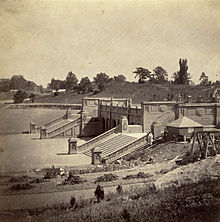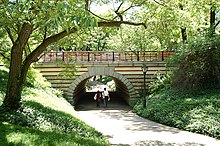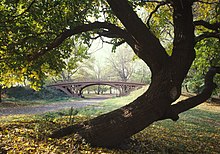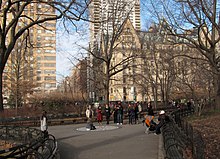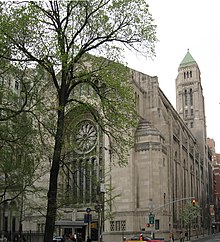Central Park

The Central Park is a city park in the center of Manhattan in New York City . It was established as a landscape park in 1859 and completed in 1873. The park is visited by over 500,000 people on some days. It was initially built primarily as a promenade for the wealthy residents. In 1963, Central Park was granted the status of a National Historic Landmark of the United States and the park was thus awarded by the US Department of the Interiorclassified as a site of particular historical importance. Central Park now stretches four miles from 59th to 110th Streets and 860 meters wide between 5th and 8th Avenues and is also known as the Green Lung of New York . With 349.15 hectares , it takes up about 6% of Manhattan's land area. Around 25 million people visit the inner-city park every year.
history
Before building
The basic idea
The original idea came from the then most important landscape designer in the USA, Andrew Jackson Downing . He responded to the population's desire for a recreational area, as there were hardly any leisure and entertainment options in what was then New York . In an article in the magazine Horticulturist in 1848, he gave the impetus to consider a large public park in which one could walk, ride a horse , row , play baseball , golf or cricket , and there should also be playgrounds .
First plans and decisions
Downing traveled to Europe to get inspiration for his proposal from the parks there. The idea was first publicly discussed in a letter from Mayor Ambrose C. Kingsland to the council in 1851.
After all, it was the wealthy businessman Robert B. Minturn and his wife Anna M. Wendell who founded a committee of like-minded citizens in order to create a park similar to the European models. The main task of the committee was to find a suitable area. But the authorities and the New Yorkers themselves had to be convinced of the benefits of a park. The prerequisites were therefore:
- there is money to be made
- new jobs would be created
- the city's cultural importance would increase
- the health of the citizens would be promoted
- political benefit
The decision was initially made on an area on the East River , which was called Jones's Wood . Jones's Wood was a swampy, hilly forest that was populated by about 1,600 people. Mostly poor immigrants and Afro-Americans lived there. On July 11, 1851, a decree was issued that allowed the city to buy the area.
After the decision for the originally intended site was reversed, the New York City Council designated an area of 280 hectares between 59th and 106th Streets for the realization of the park in 1853, at a cost of more than US $ 5 million for the land purchase alone . Among other things, the Seneca Village , a primarily African-American settlement of some prosperity, was on site, as the latest excavations show. Among other things, there was a school there, several churches, and valuable porcelain has been found during excavations.
Before the start of the construction work, it had to be determined how the system should be designed and how high the expenditure should be. Therefore, in 1857, the city founded a parking commission, the Board of Commissioners . In the same year, he launched a competition to collect suggestions for the system.
The project competition
The first draft came from Egbert L. Many . In his plan there were streets that ran through the park, a parade ground, sports facilities and a botanical garden. The commission set a budget of $ 1.5 million to make the company a reality. After many drafts, guidelines for the design were established. They stipulated that there had to be streets to connect 5th and 8th Avenues. They also wanted playgrounds, a flower garden, a lake and space for exhibition and concert halls. Thirty-three proposals were then submitted, most of them by the New Yorkers themselves.
Proposal No. 33 by Frederick Law Olmsted and Calvert Vaux won . This draft became known as the Greensward Plan . It planned to recreate the different areas of the USA in sections as a nature park , but also to integrate numerous places, playgrounds and places that serve well-being and entertainment (e.g. restaurants, observation tower). Because it should also be a park for all citizens and an oasis of relaxation. It was planned to lower the connecting roads so as not to disturb the overall impression. In addition, they wanted to largely do without architectural structures. A promenade should run along a lake. The footpaths should be away from the driveways so that you can go for a walk undisturbed. A cricket ground in the north should be easy to reach. The parking commission made only a few changes.
The founding fathers and inventors behind the scenes
- Frederick Law Olmsted was a well-known farmer and is considered the father of American landscape architecture .
- Calvert Vaux was from England and was a partner of landscape architect Andrew Jackson Downing , who died in 1853. Vaux continued Downing's work; he was known as an architect and author of architectural books.
- Andrew H. Green was the director and treasurer of the Board of Commissioners . He was therefore responsible for the timely and efficient organization of this construction project. It was also his job to hire all the specialists required to carry out all of the construction and design projects foreseen in the plans.
- Ignaz Pilat was recruited as the chief landscape gardener. He was responsible for the selection of plants and their grouping, detailed work on the site and the space-creating views that are admired today.
- Jacob Wrey Mold , “Chief Draftsman” and also a landscape architect. The ornaments and decoration of the roughly sixty bridges in the park are due to him.
- George E. Waring Jr. , engineer who developed the park's complex canal and river system.
The "Olmsted, Vaux and Company" partnership existed until the completion and official inauguration of Central Park in 1873. During this time, both worked on other park projects, including for Brooklyn, Chicago, Riverside and Illinois. Then the two separated.
The construction work and history up to 1900
The construction work began in 1858 and it can be said that it has not been completed to this day, because in the course of its creation and use, the park was repeatedly adapted and redesigned to meet new needs. However, the landscape was always preserved. By the time Central Park was inaugurated in 1873, workers had worked every inch of the site by raising or lowering the surface; they had turned natural drains into subterranean waterways, creating the illusion of picturesque abundance and distant views.
In the first five years the workers had moved, dug up, or placed in the park nearly 2.5 million yd³ (1.9 million cubic meters) of stone and earth - enough to add eight stories to a soccer field. Using picks, hammers and shovels and 166 tons of gunpowder, they blasted 300,000 yd³ of gneiss rock, interspersed with granite. The stone crushers crushed this rubble into gravel and gravel for the pavement. Contractors supplied 6 million bricks, 35,000 barrels of cement, 65,000 yd³ = 50,000 m³ gravel, and 19,000 yd³ = 15,000 m³ sand. Gardeners distributed more than 40,000 yd³ = 30,000 m³ topsoil and planted 270,000 trees and bushes. The construction work in the park gave employment to many of the unemployed. At the height of construction in 1859 and 1860, the Central Park's Board of Commissioners was one of the city's largest employers, employing 4,000 workers each year, and by September 1859, 3,600 men were working in a single day. When in 1859 some of the workers went on strike to demand higher wages, they were fired because there were enough job seekers who accepted the conditions. Despite the low wages, many were willing to work at night and on Sundays. From this immense amount of work and material - up to 20,000 men and 5 million dollars in 1866 alone - park and walking paths, bridges, hills, ponds, meadows and breathtaking views were created.
After a memorial had already been set up for Friedrich Schiller , the second oldest was erected on September 14, 1869 in honor of Alexander von Humboldt on 59th Street and Fifth Avenue.
While working on the facility, changes were made to the original plan. On the one hand, for reasons of cost, cheaper materials were used to build the numerous bridges. On the other hand, the idea of a private zoo was integrated, which found its home in the south of the complex in 1870. All kinds of animals were gifted to this zoo, including deer , geese , porcupines and prairie wolves . In addition, the pathways have been lit to make the park safer at night. Little by little, more entrances were created and paths widened.
The park was opened to the public while the work was still going on. Since the commission feared that the level of the plant could drop, usage guidelines were drawn up. This stipulated who was allowed to enter the park and when. The wealthy citizens (and financiers) felt harassed by the poor. It was forbidden to damage trees and bushes or to drive cattle to graze in the park. Furthermore, the usual mass picnics or military parades were not allowed to take place in order not to disturb the attractiveness.
The picturesque, 18-acre lake was once a swamp area. After construction work in 1857, the lake was first opened for ice skating in the winter of 1858. Until 1950 the lake was used for ice skating in the winter months and for boating in the summer. In 1950 the Wollman ice rink opened, which is popular and attracts over 4,000 skaters a day during the winter months.
In 1870 the administration passed into the hands of the mayor, A. Oakey Hall, who established a new parking commission. Olmsted and Vaux were sacked as landscape architects for criticizing the city's work too much. In fact, however, the new commission completed projects that could previously only be dealt with superficially. Vaux was later hired again as a landscape architect, but his sphere of activity was smaller.
At the time of the Great Depression, poor people who had become homeless built huts in the park.
Belvedere Castle
Named after the Italian word for "beautiful view", Belvedere Castle offers walkers exactly what the name suggests. The castle is on a hill called Vista Rock, making it the highest point in the park. With its two balconies, it provides a wonderful panoramic view of some of the most beautiful and famous sights in the park: the Delacorte Theater, where free Shakespeare plays are performed in summer , and the Turtle Pond (turtle pond) directly below, on the Great Lawn (Large meadow) and on the Ramble (primeval forest).
Originally designed by Calvert Vaux in 1865, Belvedere Palace is a Victorian fantasy building. With its strong stone facade, the large tower with a flag, the castle was a popular attraction in Central Park.
In 1919, the national meteorological service began taking measurements to determine the wind speed and direction from the castle tower with scientific instruments. In addition, other data, such as rainfall, was recorded south of the castle and relayed to the Meteorological Forecast Bureau at the National Library of Brookhaven on Long Island. Belvedere Palace is still used for this purpose today. Through the Henry Luce Nature Observatory, named after the philanthropist and founder of the "Time" magazine, which is also located in the castle, the park rangers bring young visitors closer to the diverse fauna of the park through showcases and bird watching.
Bethesda terrace and fountain
With breathtaking views of Central Park Lake and the woods, Bethesda Terrace, located on 72nd Street Cross Drive, is an architectural marvel. The terrace was one of the very first structures in Central Park. Construction began in 1859, stopped during the Civil War and was completed in 1863. When designing the terrace, Frederick Law Olmsted and Calvert Vaux agreed that nature was paramount in their plan and that architecture had to take a back seat. They suggested that the terrace should become known as the “heart of the park” and Vaux is said to have said: “Nature first, second and third - architecture after a while”. The vision of the two creators was a place where people could experience nature. It should be a refuge from the often stressful and busy urban life of the typical city dweller. Jacob Wrey Mold , the designer of the Bethesda Fountain, supported Olmsted and Vaux in their view of focusing on nature, and created the decorative elements for the terrace with his designs. The layout consists of both an upper and a lower terrace, which is flanked by two large flights of stairs, and a smaller one, which leads directly to the attached mall with the majestic Bethesda Fountain (Bethesda Fountain). The entire deck is built with New Brunswick sandstone, paved with Roman brick, and has granite steps and landings. From here you have a fantastic view of the park.
Central Park Dairy
At the southern end of the park originally intended for the children, the dairy was built in 1870 to distribute fresh milk for children. Here, the children could be offered snacks in addition to milk in the cool and relaxing atmosphere of the nearby pond.
Vaux also recognized the need for a boathouse and designed a wooden Victorian-style structure that was two-story. It stood from 1873 to 1954 until it was torn down and replaced by the “Loeb” boat house.
obelisk
There are three obelisks from Egypt in Manhattan. In the park is the 21 m high column , wrongly named after Cleopatra (Cleopatra's Needle) , which is around 1,600 years old. The gift of the Egyptian government (for economic support from the city) has long towered over all New York buildings.
The park since 1900
Effects of the enormous expansion of New York until 1945
While the structure of the park was preserved, its environment changed at the beginning of the 20th century. Ever new skyscrapers framed the facility and gave it a different appearance. Cars slowly became a part of the cityscape, and the middle class now also became affordable. So that the park was not overloaded by through traffic, traffic lights were set up and speed restrictions were issued.
Again and again there were plans to use parts of the park as construction site - the New York Times of March 31, 1918 gives an illustrated overview of these (mostly declared socially valuable) projects: They ranged from exhibition and sports facilities, an opera house and one From a cathedral to a hippodrome - there were successful protests against it. Only the Metropolitan Museum of Art was realized. Later, however, a large number of new playground equipment was installed in the park, their number rose to 424. Paths were renewed, trees and bushes cut and removed to present new views. A security service took care of illegal sellers, homeless people and the garbage. Public voices said the park was already almost more like an amusement park than a natural landscape.
Increasing crime from 1945
After the Second World War , New York grew into a metropolis of international capitalism . Despite the parallel economic growth, poverty increased. One consequence of this was the increasing number of robberies in the park. It was not recommended to enter the park at night. Homelessness , drug use and prostitution were increasingly becoming part of everyday life in the park.
In May 1963, the park was granted National Historic Landmark status . In the mid-1960s, Central Park became popular as a location for concerts by the New York Philharmonic Orchestra , the Metropolitan Opera, and large political gatherings. Conservative circles feared the park's image; However, restrictions on the right of assembly could not be enforced. With the economic recession of the 1970s, the city lacked more and more financial means, so that the park was neglected and partially deteriorated.
Concerts for Central Park
Since the city council of New York and its Mayor Ed Koch planned to close Central Park for cost reasons, artists got involved in its preservation and organized benefit concerts for this purpose. On September 19, 1981 , Simon & Garfunkel gave a famous concert, later released as a live album, in front of over 500,000 spectators. Paul Simon thanked Ed Koch for staging the concert in an ironic tone, which led to great applause.
The Central Park Conservancy
In 1980 the Central Park Conservancy was founded, a private initiative that initially looked after the neglected park on its own and is now mainly supported by donations from large companies and banks. It is thanks to the commitment of this organization that the landscape of the park is maintained. Private donations make up around 85% of the park's budget. In addition, the Central Park Conservancy offers guided tours of the park to familiarize citizens with the beauty of the flora and fauna and their conservation value. These offers are popular. The numerous works of art in the park from different times a. the Strawberry Fields Memorial by Yoko Ono (→ Strawberry Fields Forever ) are part of her field of work.
Since its inception, the Conservancy has managed $ 690,000,000 in Central Park investments, of which $ 536,000,000 has been raised from private sources - individuals, corporations, and foundations - and more than $ 110,000,000 has been contributed by the city.
Since April 13, 2005, the Central Park Conservancy has also received support from the even younger Austrian Cultural Forum , which, with the Ignaz Pilat Society, has been helping to renovate “The Ramble” - an 18 hectare primeval forest in the middle of the park, which was formerly designed by Pilat . The Austrian Cultural Forum supports the Central Park Conservancy with donations and voluntary work that Austrians abroad carry out together with New Yorkers - entirely in the spirit of cultural exchange and the redevelopment of the section of the park, and not least for self-promotion or to increase the popularity of the "almost forgotten" Pilat.
Conservancy employees are responsible for maintaining 250 acres of meadows, 24,000 trees, 150 acres of lakes and streams, and 80 acres of forest. They install hundreds of thousands of plantings annually, including bulbs, shrubs, flowers and trees, maintain 9,000 benches, 26 playgrounds and 21 ball game fields, preserve 55 sculptures and monuments and 36 bridges, remove graffiti within 24 hours, collect over 5 million pounds of garbage per year and provide support for horticulture in other city parks.
The largest single donation
On October 23, 2012, the Central Park Conservancy announced that it had received $ 100 million from the John A. Paulson Family Foundation for the maintenance of the large park. It is the highest amount Central Park has ever received.
The Gates of Christ
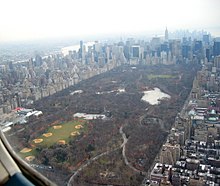
at the bottom left: Metropolitan Museum of Art
From February 12 to 28, 2005, after decades of discussions and delays with the city administration in Central Park , the artist couple Christo and Jeanne-Claude realized the art project The Gates , an installation with 7,500 gates made of saffron-colored panels.
Nomination for the UNESCO World Heritage
In April 2017, Central Park, along with Brooklyn Bridge and Ellis Island, was put on the tentative list by the United States Department of the Interior and thus nominated as a UNESCO World Heritage Site .
Attractions in and around Central Park
Lakes

There are several lakes in Central Park. The most well-known are:
- The Reservoir: By far the largest lake. Since 1994 it has officially been called the Jacqueline Kennedy Onassis Reservoir .
- The Lake: The second largest lake, the shape of which is completely different from the rather sterile appearance of the reservoir. At the narrowest point it is spanned by the Bow Bridge .
- Harlem Meer: Located in the extreme northeast.
- The Pond: In the very southeast of the park, right in front of the Plaza Hotel.
- Belvedere Lake: Located right in the center of the park, west of the Metropolitan Museum, also known as Turtle Pond.
- The Pool: In the northwest of the park.
- Conservatory Water: Located to the east of the park, approximately level with The Carlyle .
- Wollman Rink: Not a lake in the strict sense of the word. In winter you can ice skate here in the southeast of the park.
building
southeast

Today the luxury hotels The Pierre , The Sherry-Netherland Hotel and the famous Plaza Hotel are located here . There is also 745 5th Avenue (formerly the Squibb Building ) , built as a typical wedding cake from the 1930s, and the International-style General Motors Building .
Until the 1960s, this area of Central Park, believed to be the most photographed area, looked different. Instead of the General Motors Building , there was the eye-catching Savoy Plaza Hotel , another luxury hotel. The demolition and subsequent construction of the General Motors Building , which hardly fits into the row of surrounding buildings, is still considered controversial and, together with the demolition of the Singer Building, one of the biggest mistakes of New York city planners. Even today you can find many postcards and posters on which the old skyline of this area is shown, i.e. with the Savoy-Plaza Hotel .
south
West of the Plaza Hotel , the fall Hampshire House (with green copper roof) and the Essex House (carrying the highly visible lettering Essex House on the roof) on. The skyline behind it, of which the black and white Solow Building is particularly striking, is significantly higher.
west
The 229 m high twin towers of the Time Warner Center have been in the southwest since 2004 .
Along the west side (Central Park West) there are various apartment buildings, most of which are very luxurious and in which many celebrities live.
The four twin towers The Century , The Majestic , The San Remo and The Eldorado , built in the 1930s, are particularly noticeable . The San Remo is the best known and also the most striking of these four. Between The Majestic and The San Remo stands the lower, but most famous and oldest of the apartment buildings in Central Park: The Dakota . Here u lived a. John Lennon who was murdered outside the gate. The Beresford ,
also built in the 1930s, has three towers and is reminiscent of a castle. 55 Central Park West , built
in the Art Deco style , is best known for the movie Ghostbusters and has been called the Ghostbusters Building ever since .
The American Museum of Natural History on 79th Street is one of the largest natural history museums in the world.
east
The two hotels The Pierre and The Sherry-Netherland are followed by numerous apartment buildings, many of which were built immediately after the Second World War. These continued to be built in the Art Deco style and line up with the structural environment of Central Park.
The tallest and most noticeable building on the Upper East Side is The Carlyle (it's not right on Central Park, but a block back on Madison Avenue ). The building, designed in the Art Deco style with a green roof, can be seen from afar.
The Solomon R. Guggenheim Museum is a museum for modern art. The eye-catching building was designed by Frank Lloyd Wright and opened in 1959.
The Temple Emanu-El is the largest synagogue in the world and is located at the level of Central Park Zoo .
Across the street, on the eastern edge within Central Park, is the Metropolitan Museum of Art , one of the world's largest and most visited art museums.
Data
- 341 hectares of land
- 15 years of construction
- $ 7.5 million
- 93.5 kilometers of footpaths
- 275 species of birds
- 25 million visitors per year
- 4.07 km long
- 860 m wide
If you don't know where you are in the park, you can use any of the over 1,500 parking lights to find your way around. A sticker of at least four digits has been attached to each base since 1907. The first two numbers represent the height of the next street and the last number says whether it is on the east or west side (odd number). So it's not just a simple numbering of the lamps for the electrician.
Musical dedications
The American composer Charles Ives wrote a tone poem in 1906 under the title Central Park in the Dark .
The park is also mentioned in the piece A Heart in New York (1981) by the American singer Art Garfunkel :
New York, to that tall skyline I come,
flying in from London to your door.
New York, looking down on Central Park
where they say you should not wander after dark.
As in Bernadette (1997) by Paul Simon :
When the leaves are dark
I've got a hiding place in Central Park
And the sky is a coat of diamonds
In their world hit Miss You (1978), the Rolling Stones paid homage to Central Park:
I've been walking in Central Park
Singing after dark
People think I'm crazy
I've been stumbling on my feet
Shuffling through the street
Asking people, what's the matter with you boy?
Movies
- Central Park. The heart of Manhattan. Documentation, Germany 2006, 43 min., Director: Curt Faudon , production: WDR , first broadcast: March 30, 2006, summary by arte .
- Enigmatic Central Park . 2016, documentation, 2 × 46 min.
- The Gates. Documentation, USA, 2007, 87 min., Written and directed: Antonio Ferrera, Albert Maysles , table of contents ( Memento from December 3, 2013 in the Internet Archive ) by Arte and Origin ( Memento from January 31, 2009 in the Internet Archive ).
- The gardens of New York. Documentation, Germany, 2007, 43 min., Director: Veronika Hofer, production: BR , summary by Arte.
- The ruler of Central Park (The Park is Mine)
Television series
- Central Park , 2020
literature
sorted alphabetically by author
- Clarence Cook: A description of the New York Central park . With drawings by AF Bellows. Publisher: FJ Huntington New York, 1869.
- Franziska Kirchner: Central Park - an American-German cooperation . In: Die Gartenkunst 18 (1/2006), pp. 55–68.
- Franziska Kirchner: The Central Park in New York and the influence of the German garden theory and practice on its design (= Green Row 23). Wernersche Verlagsgesellschaft, Worms 2002. ISBN 3-88462-178-5
- Sara Cedar Miller: The Central Park Design Team . In: Die Gartenkunst 18 (1/2006), pp. 173–182.
- HE Parkhurst: Trees, shrubs and vines of the northeastern United States; their characteristic landscape features fully described for identification by the non-botanical reader; together with an account of the principal foreign hardy trees, shrubs and vines cultivated in our country, and found in Central park, New York city . Publisher: C. Scribner's sons New York, 1903.
- Robert Schediwy and Franz Baltzarek: Green in the big city. Vienna 1982.
Web links
Individual evidence
- ↑ Central Park Conservancy ( Memento of the original from August 24, 2007 in the Internet Archive ) Info: The archive link was automatically inserted and not yet checked. Please check the original and archive link according to the instructions and then remove this notice.
- ↑ Diana diZerega Wall, Nan A. Rothschild, Meredith B. Linn, and Cynthia R. Copeland: SENECA VILLAGE, A FORGOTTEN COMMUNITY: REPORT ON THE 2011 EXCAVATIONS . ( nyc.gov [PDF]).
- ^ The Greensward plan.
- ^ Building the Park.
- ↑ Central Park Zoos.
- ↑ Wollman Rink.
- ↑ Pictures of Venetian gondolas on the lake in Central Park, around 1900 pinterest.de, accessed on January 22, 2018.
- ↑ Belvedere Castle and other links in Central Park. At: lovetoeatandtravel.com.
- ↑ Belvedere Castle. At: centralpark.com.
- ^ Jacob Wrey Mold Fountain, City Hall Park. ( Memento of the original from November 2, 2013 in the Internet Archive ) Info: The archive link was inserted automatically and has not yet been checked. Please check the original and archive link according to the instructions and then remove this notice.
- ^ Dairy.
- ^ Loeb Boathouse.
- ↑ For the hieroglyphs on it and the transport details compare Cleopatra's Needle on the English Wikipedia (with pictures)
- ↑ Listing of National Historic Landmarks by State: New York. National Park Service , accessed August 18, 2019.
- ↑ Central Park. Retrieved December 12, 2011 .
- ^ About the Central Park Conservancy.
- ^ Gift of $ 100 Million for Central Park (October 23, 2012).
- ↑ Entry Central Park on UNESCO website
- ↑ reservoir. Retrieved July 25, 2012 .
- ↑ Text and music: "Miss You"
Coordinates: 40 ° 46 ′ 57 " N , 73 ° 57 ′ 58" W.



